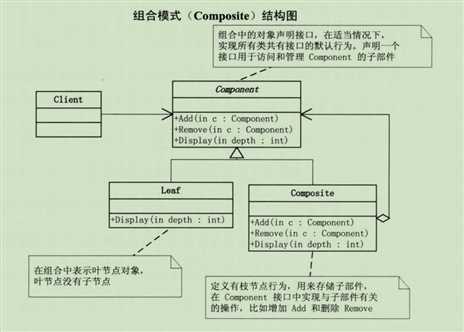标签:lis rip 结构图 需求 对象 modified 表示 his test
将对象组合成树形结构以表示‘部分--整体’的层次结构。组合模式使得用户对单个对象和组合对象的使用具有一致性

在组合模式结构图中包含如下几个角色:
● Component(抽象构件):它可以是接口或抽象类,为叶子构件和容器构件对象声明接口,在该角色中可以包含所有子类共有行为的声明和实现。在抽象构件中定义了访问及管理它的子构件的方法,如增加子构件、删除子构件、获取子构件等。
● Leaf(叶子构件):它在组合结构中表示叶子节点对象,叶子节点没有子节点,它实现了在抽象构件中定义的行为。对于那些访问及管理子构件的方法,可以通过异常等方式进行处理。
● Composite(容器构件):它在组合结构中表示容器节点对象,容器节点包含子节点,其子节点可以是叶子节点,也可以是容器节点,它提供一个集合用于存储子节点,实现了在抽象构件中定义的行为,包括那些访问及管理子构件的方法,在其业务方法中可以递归调用其子节点的业务方法。
当发现需求中体现部分与整体层次的结构时,以及你希望用户可以忽略组合对象与单个对象的不同,统一的使用组合结构中的所有对象时,就可以考虑组合模式
透明方式: 可以理解为在component中声明用来管理所有子对象的方法,其中包括add remove等。这样实现component接口的所有子类都具备了add和remove。这样做的好处就是叶节点和枝节点对于外界没有区别,他们具有完全一致的行为接口。但是问题也明显,因为leaf类本身不具备add
remove方法的功能,所有实现他们是没有意义的
安全方式: 在component接口中不去声明add remove方法,那么子类的leaf也就不需要去实现它,而是在composite声明所有用来管理子类对象的方法,这样的好处不会出现上述透明方式的问题,但问题是 由于不够透明,所有树叶和树枝类将不具有相同的接口,客户端的调用需要做相应的
判断,带来了不便。
抽象构件
package com.chenpt.designModel.compositeModel;
/**
* @Author: chen
* @Description:
* @Date: created in 2018/8/27
* @Modified By:
*/
public interface AbstractFile {
void add(AbstractFile c);
void remove(AbstractFile c);
AbstractFile getChild(int i);
void operation();
}
叶子节点1
package com.chenpt.designModel.compositeModel;
/**
* @Author: chen
* @Description:
* @Date: created in 2018/8/27
* @Modified By:
*/
public class ImageFile implements AbstractFile {
String name;
ImageFile(String name){
this.name=name;
}
@Override
public void add(AbstractFile component) {
System.out.println("对不起,不支持该方法!");
}
@Override
public void remove(AbstractFile component) {
System.out.println("对不起,不支持该方法!");
}
@Override
public AbstractFile getChild(int i) {
System.out.println("对不起,不支持该方法!");
return null;
}
@Override
public void operation() {
//模拟杀毒
System.out.println("----对图像文件‘" + name + "‘进行杀毒");
}
}
叶子节点2
package com.chenpt.designModel.compositeModel;
/**
* @Author: chen
* @Description:
* @Date: created in 2018/8/27
* @Modified By:
*/
public class TextFile implements AbstractFile {
String name;
TextFile(String name){
this.name=name;
}
@Override
public void add(AbstractFile component) {
System.out.println("对不起,不支持该方法!");
}
@Override
public void remove(AbstractFile component) {
System.out.println("对不起,不支持该方法!");
}
@Override
public AbstractFile getChild(int i) {
System.out.println("对不起,不支持该方法!");
return null;
}
@Override
public void operation() {
//模拟杀毒
System.out.println("----对文本文件‘" + name + "‘进行杀毒");
}
}
容器构件
package com.chenpt.designModel.compositeModel;
import java.util.ArrayList;
/**
* @Author: chen
* @Description:
* @Date: created in 2018/8/27
* @Modified By:
*/
public class Folder implements AbstractFile {
private ArrayList<AbstractFile> fileList=new ArrayList<AbstractFile>();
private String name;
public Folder(String name) {
this.name = name;
}
@Override
public void add(AbstractFile c) {
fileList.add(c);
}
@Override
public void remove(AbstractFile c) {
fileList.remove(c);
}
@Override
public AbstractFile getChild(int i) {
return fileList.get(i);
}
@Override
public void operation() {
System.out.println("****对文件夹‘" + name + "‘进行杀毒"); //模拟杀毒
//递归调用成员构件的killVirus()方法
for(AbstractFile obj : fileList) {
obj.operation();
}
}
}
客户端
package com.chenpt.designModel.compositeModel;
/**
* @Author: chen
* @Description:
* @Date: created in 2018/8/27
* @Modified By:
*/
public class MainTest {
public static void main(String[] args){
//针对抽象构件编程
AbstractFile file1,file2,file3,folder1,folder2,folder3;
folder1 = new Folder("chenpt的资料");
folder2 = new Folder("图像文件");
folder3 = new Folder("文本文件");
file1 = new ImageFile("小龙女.jpg");
file2 = new ImageFile("张无忌.gif");
file3 = new TextFile("九阴真经.txt");
folder2.add(file1);
folder2.add(file2);
folder3.add(file3);
folder1.add(folder2);
folder1.add(folder3);
folder1.operation();
}
}
//执行结果
****对文件夹‘chenpt的资料‘进行杀毒
****对文件夹‘图像文件‘进行杀毒
----对图像文件‘小龙女.jpg‘进行杀毒
----对图像文件‘张无忌.gif‘进行杀毒
****对文件夹‘文本文件‘进行杀毒
----对文本文件‘九阴真经.txt‘进行杀毒
标签:lis rip 结构图 需求 对象 modified 表示 his test
原文地址:https://www.cnblogs.com/chenpt/p/9542848.html